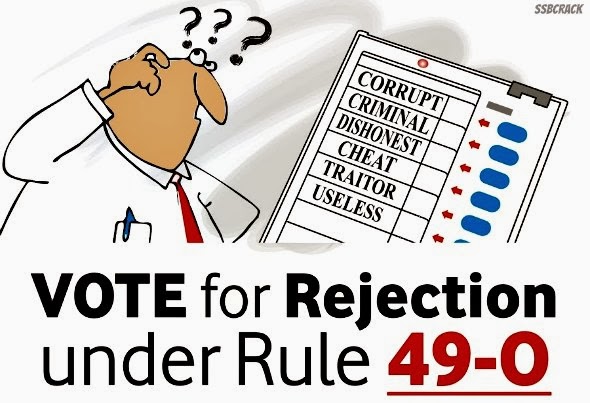Friends recently questions are being asked in interviews about NOTA, i.e. none of the above The Supreme Court of India on 27 September 2013 held that citizens have the right to reject all candidates contesting an election. From SSB point of view this is an important issue. Let’s have a look what are the provisions of this right and how it will affect our elections in near future.
Existing Provisions in Representation of People Act
Court judgment and its implementation
- A bench headed by Chief Justice P Sathasivam while pronouncing the judgment viewed that negative voting would foster purity and vibrancy of elections .
- It also ensures wide participation as people who are not satisfied with the candidates in the fray would also turn up to express their opinion rejecting contestants.
- After that Election Commission of India Approved None of the Above Option in EVMs and Ballot Papers. The NOTA option was made mandatory by the Supreme Court of India on 27 September 2013 and gave the direction to the Election Commission of India to provide none of the above options at the end of the list of candidates contesting an election in a constituency.
- The Election Commission of India on 28 October 2013 clarified that if the number of electors who had utilized the NOTA (None of the above candidates) option in the EVM or Ballot paper exceeded the votes polled by any of the candidates, the candidate with the highest number of votes would be declared winner.
- Sole objective of giving the voter a wider choice.
- Democracy is all about choices. So, voters will be empowered by this right of negative voting.
- Negative voting will send a clear signal to political parties and candidates as to what the voters think about them.
- The concept of negative voting is prevalent in 13 countries. Even in India parliamentarians are given an option to press the button for abstaining while voting takes place in the Parliament.
- The right to reject candidates in elections is part of fundamental right given by the Constitution in article 19 (freedom of speech and expression).
- Presently, it will only enable a voter not to vote in favour of any candidate. So the votes recorded against this button will have the same effect as the ‘invalid’ votes of the ballot paper time and would have no role in determining the winner.
- With EVMs, the ‘invalid vote’ category got eliminated as mistakes like wrong marking and multiple marking became a thing of the past. Now, with this button that column will come back to life.
- it as it may increase voter turnout, an aspect which the Supreme Court judges also pointed out.
- it will make parties more responsible, which will nominate better candidates. The judges themselves pointed out that it can widen participation and curb impersonation.
- How Does an Aircraft Flies?
- SSB Interview Technical Questions for Engineering Students
- Article on Egypt Unrest
- Syrian Civil War And Its Effects On International Politics
 Gaurav Vaishnav, Editorial Team
Gaurav Vaishnav, Editorial Team








